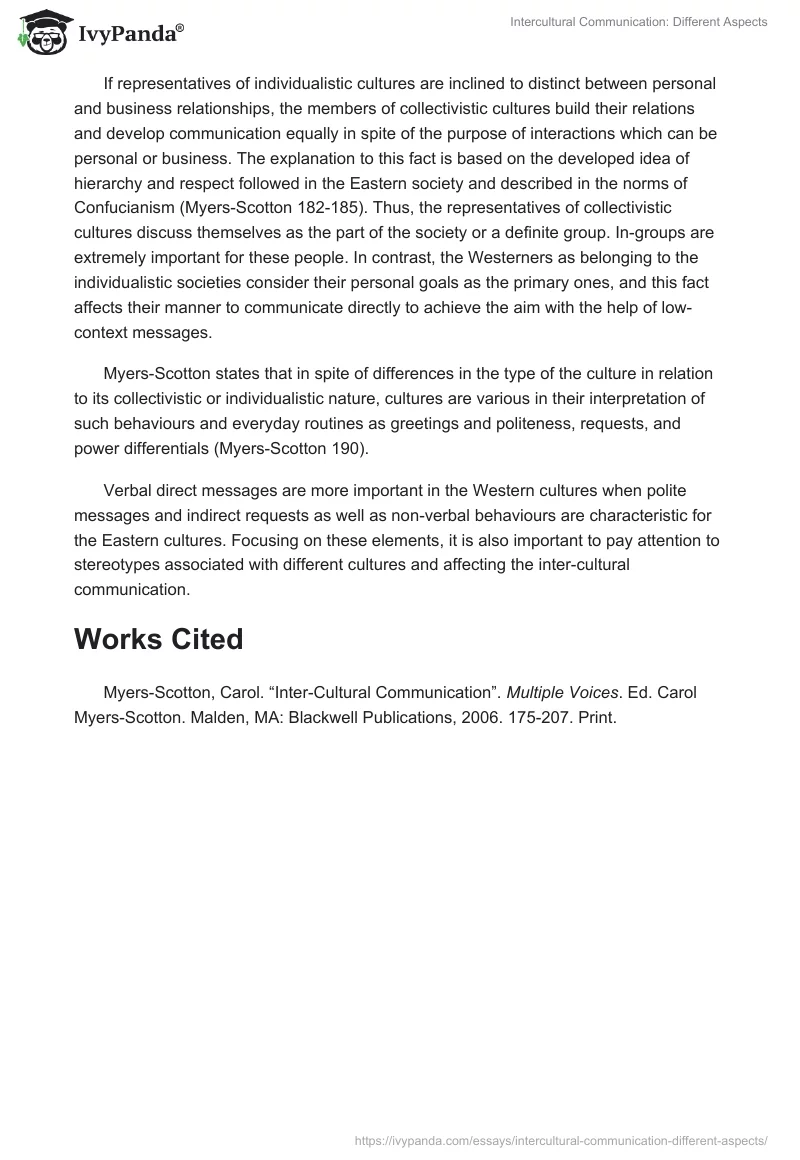Globalisation makes people pay more attention to diverse cultures and to the particular features of the inter-cultural communication. Discussing the main aspects of the inter-cultural communication, Carol Myers-Scotton focuses on the role of globalisation in the process, on differences between collectivistic and individualistic cultures which influence the particular features of the representatives’ communication, and on high-context and low-context societies. According to Myers-Scotton, to avoid the difficulties associated with the inter-cultural communication, it is necessary to pay attention to the specifics of different cultures because these details affect the people’s interactions within societies significantly.
Changes in transportation and communication technologies along with changes in immigration patterns caused by the globalisation process are the triggers to stimulate the inter-cultural communication. Inter-cultural or cross-cultural communication is the communication in a language that is not native for both the speakers (Myers-Scotton 176). Culture is also an important factor to influence this type of communication as well as the aspect of language because culture reflects the collective knowledge and values of the definite group of people. However, these values are represented through the personal vision. Various knowledge and different values can become the first barriers to communicate successfully. Each culture is characterised by the definite set of rules, norms, and traditions which should be referred to during communication.
The most general classification of cultures is the division into collectivistic cultures and individualistic cultures. The Western cultures are traditionally individualistic ones when the Eastern cultures are collectivistic in their nature (Myers-Scotton 179). It is typical for individualistic cultures to use the low-context messages in order to represent the certain idea directly. They can talk much about different aspects, their requests are often direct and open, and equality in communication is appreciated. On the contrary, the Eastern cultures which are often collectivistic ones are characterised by the lack of talk. It is important to note that silence is appreciated, hierarchy is the most important factor to determine the features of communication, the requests are indirect, and messages are presented as high-context ones.
If representatives of individualistic cultures are inclined to distinct between personal and business relationships, the members of collectivistic cultures build their relations and develop communication equally in spite of the purpose of interactions which can be personal or business. The explanation to this fact is based on the developed idea of hierarchy and respect followed in the Eastern society and described in the norms of Confucianism (Myers-Scotton 182-185). Thus, the representatives of collectivistic cultures discuss themselves as the part of the society or a definite group. In-groups are extremely important for these people. In contrast, the Westerners as belonging to the individualistic societies consider their personal goals as the primary ones, and this fact affects their manner to communicate directly to achieve the aim with the help of low-context messages.
Myers-Scotton states that in spite of differences in the type of the culture in relation to its collectivistic or individualistic nature, cultures are various in their interpretation of such behaviours and everyday routines as greetings and politeness, requests, and power differentials (Myers-Scotton 190).
Verbal direct messages are more important in the Western cultures when polite messages and indirect requests as well as non-verbal behaviours are characteristic for the Eastern cultures. Focusing on these elements, it is also important to pay attention to stereotypes associated with different cultures and affecting the inter-cultural communication.
Works Cited
Myers-Scotton, Carol. “Inter-Cultural Communication”. Multiple Voices. Ed. Carol Myers-Scotton. Malden, MA: Blackwell Publications, 2006. 175-207. Print.


